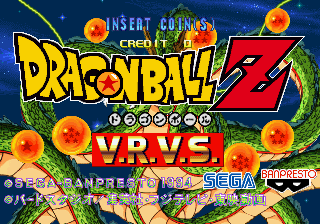Difference between revisions of "Dragon Ball Z V.R.V.S."
From Sega Retro
| Line 7: | Line 7: | ||
| developer=[[Sega AM3]], [[Banpresto]] | | developer=[[Sega AM3]], [[Banpresto]] | ||
| system=[[Sega System 32]] | | system=[[Sega System 32]] | ||
| − | | romsize= | + | | romsize=22.3 MB |
| sounddriver= | | sounddriver= | ||
| peripherals= | | peripherals= | ||
Revision as of 01:20, 21 November 2015
This teeny-tiny article needs some work. You can help us by expanding it.
| Dragon Ball Z V.R.V.S. | |||||
|---|---|---|---|---|---|
| System(s): Sega System 32 | |||||
| Publisher: Sega | |||||
| Developer: Sega AM3, Banpresto | |||||
| Genre: Fighting | |||||
| Number of players: 1-2 | |||||
|
Dragon Ball Z V.R.V.S. is a third-person fighting game based on the Dragon Ball Z franchise, and was released for Sega System 32 arcade hardware exclusively in Japan. The cabinet features motion sensors, meaning it can be played by physically punching and kicking in a similar manner to the Sega Activator.
Although the game uses 2D sprites, it uses third-person, over-the-shoulder camera angles positioned behind the characters along with sprite scaling to create a 3D-like experience. The game is controlled with a joysick and 3 buttons, while a deluxe edition of the game features motion sensors that allow the player to move his or her body to control the character in the game.
The technology used was similar to that of the Sega Activator peripheral for the Mega Drive console, but with extra sensors to pull off better reaction sensing. This was thus the first successful example of full-body motion sensing in a video game.
Promotional Material
Physical Scans
| System 32, JP | ||||
|---|---|---|---|---|
| Dragon Ball Z games for Sega systems | |
|---|---|
| Dragon Ball Z V.R.V.S. (1994) | |
| Dragon Ball Z: Buyuu Retsuden (1994) | |
| Dragon Ball Z: Shinbutouden (1995) | Dragon Ball Z Idainaru Dragon Ball Densetsu (1996) | |
| Unlicensed Dragon Ball Z games for Sega systems | |
| Dragon Ball: Final Bout (1998) | |

